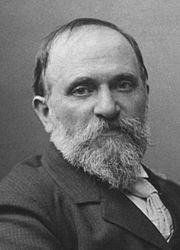Thomas Hovenden facts for kids
Quick facts for kids
Thomas Hovenden
|
|
|---|---|

Thomas Hovenden in 1895
|
|
| Born | December 28, 1840 Dunmanway, Co. Cork, Ireland
|
| Died | August 14, 1895 (aged 54) |
| Nationality | Irish |
| Education | Cork School of Design National Academy of Design École des Beaux Arts under Cabanel |
| Known for | Painting |
|
Notable work
|
The Last Moments of John Brown (1884) Breaking Home Ties (1890) |
| Spouse(s) | Helen Corson Hovenden |
Thomas Hovenden (born December 28, 1840 – died August 14, 1895) was an Irish artist and teacher. He lived most of his life in the United States. Hovenden was known for painting realistic scenes of family life and stories. He also often painted African Americans.
Contents
Early Life and Art Training
Thomas Hovenden was born in Dunmanway, a town in County Cork, Ireland. When he was six years old, his parents died during the time of the Great Famine. He was then placed in an orphanage.
As a young boy, he became an apprentice to a carver and gilder. This means he learned how to carve wood and apply gold leaf to objects. During this time, he also studied art at the Cork School of Design.
Moving to America and Paris
In 1863, Thomas Hovenden moved to the United States. He continued his art studies at the National Academy of Design in New York City.
A few years later, in 1868, he moved to Baltimore. Then, in 1874, he traveled to Paris, France. In Paris, he studied at the famous École des Beaux-Arts, a well-known art school. His teacher there was Alexandre Cabanel.
However, Hovenden spent most of his time with a group of American artists in a place called Pont-Aven in Brittany, France. This group was led by an artist named Robert Wylie. While in Pont-Aven, Hovenden painted many pictures of the local farmers and villagers.
Life in Pennsylvania
Thomas Hovenden returned to America in 1880. He became a member of the Society of American Artists. He also joined the National Academy of Design as an Associate member and later became a full Academician in 1882.
In 1881, he married Helen Corson. She was an artist he had met while in Pont-Aven. They settled at her family's home in Plymouth Meeting, Pennsylvania, which is near Philadelphia.
Helen's family were abolitionists. This means they were against slavery and worked to end it. Their home was even a stop on the Underground Railroad. The Underground Railroad was a secret network that helped enslaved people escape to freedom.
The barn at their home was later used as Hovenden's art studio. It was known as "Abolition Hall" because anti-slavery meetings were held there.
Famous Paintings
One of Hovenden's most famous paintings is The Last Moments of John Brown. He was asked to paint this historical picture by Mr. Robbins Battell. The painting shows the abolitionist leader John Brown just before his execution. Hovenden finished this painting in 1884. You can see copies of it in important museums like the Metropolitan Museum of Art in New York and the deYoung Museum in San Francisco.
Another very popular painting by Hovenden was Breaking Home Ties. This painting shows a scene of American farm life and was widely admired.
Thomas Hovenden also taught art. Some of his students became famous artists themselves. These included the sculptor Alexander Stirling Calder and Robert Henri, who was a leader of the Ashcan School of art.
Later Life and Legacy
Sadly, Thomas Hovenden died at the age of 54. He was killed in a train accident near his home in Plymouth Meeting. Newspaper reports at the time said he was trying to push a ten-year-old girl out of the train's path.
Today, a historical marker in Plymouth Meeting remembers Abolition Hall and Thomas Hovenden. The Hovenden House, Barn and Abolition Hall was added to the National Register of Historic Places in 1971. He is buried in the cemetery of the Plymouth Friends Meetinghouse.
Selected Works
- Self-Portrait of the Artist in His Studio, 1875, Yale University Art Gallery
- Image Seller, 1876, Metropolitan Museum of Art
- News from the Conscript, 1877
- Loyalist Peasant Soldier of La Vendée, 1877
- A Breton Interior, 1793, 1878, Metropolitan Museum of Art
- In Hoc Signo Vinces, 1880, Detroit Institute of Arts, Michigan
- The Old Version, 1881, San Francisco Museum of Fine Art
- Sunday Morning, 1881, San Francisco Museum of Fine Art
- Chloe and Sam, 1882, Amon Carter Museum
- Death of Elaine, 1882, Westmoreland Museum of American Art, Pennsylvania
- The Last Moments of John Brown, 1882–4, Metropolitan Museum of Art
- Taking His Ease, 1885, San Francisco Museum of Fine Art
- Breaking Home Ties, 1890, Philadelphia Museum of Art
- Bringing Home the Bride, 1893, University of St. Thomas, St. Paul, Minnesota
- Jerusalem the Golden, 1894, Metropolitan Museum of Art
-
Hovenden's studio, Plymouth Meeting, Pennsylvania.
-
Chloe and Sam (1882), Amon Carter Museum.
-
I Know'd It Was Ripe (c.1885), Brooklyn Museum.








